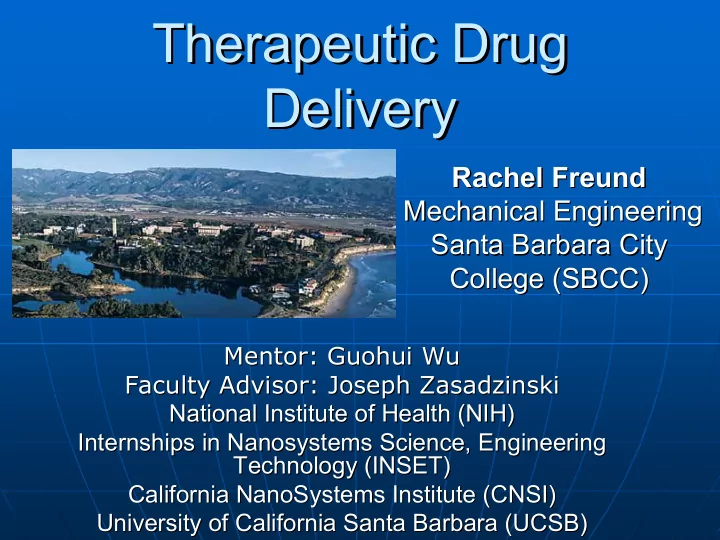

Therapeutic Drug Therapeutic Drug Delivery Delivery Rachel Freund Rachel Freund Mechanical Engineering Mechanical Engineering Santa Barbara City Santa Barbara City College (SBCC) College (SBCC) Mentor: Guohui Guohui Wu Wu Mentor: Faculty Advisor: Joseph Zasadzinski Zasadzinski Faculty Advisor: Joseph National Institute of Health (NIH) National Institute of Health (NIH) Internships in Nanosystems Science, Engineering Internships in Nanosystems Science, Engineering Technology (INSET) Technology (INSET) California NanoSystems Institute (CNSI) California NanoSystems Institute (CNSI) University of California Santa Barbara (UCSB) University of California Santa Barbara (UCSB)
Current anti-cancer drug delivery methods are not satisfactory Typically, a few percent of drug dose reaches intended tissues due � to premature release from vesicles Higher dose causes side-effects � Current delivery technology produces a new generation of vesicles � known as vesosomes Their current large size makes them vulnerable to the immune � system Objective : synthesize smaller vesosomes, that are biocompatible and stable within the human body
Nano-Encapsulation for Targeted Delivery of Drugs � Liposome-Based Delivery Vehicle � Cell-Mimic: Vesosomes � Unilamellar Vesicles General Structure of double-tailed phospholipids. The Vesosome The Liposome
Improving Nanoparticles for Targeted Drug Delivery Experimental objectives : Decrease typical vesosomes from 0.4 – 100 µm to < 0.4 µm � Narrow size distribution of vesosomes � n Current Desired Number of Vesicles 0 100 0.4 Size (µm) of vesosomes
Experimental Design Modifying three critical process variables: � Polymer selection - changes bilayer curvature � Poloxamer 188 � Brij 700 � Concentration optimization � Range: 1 – 12 mg / mL � Down scaling synthesis � Extrusion � Sonication
Procedure � Sample: � Dipalmitoylphosphatidychloline lipid (DPPC) � Extrusion / Sonication � Interdigitation � Freeze Fracture (FF) / Replication � Transmission Electron Microscopy (TEM)
Materials / Methods The Mini - Extruder Reduces the size of the vesicles Size reduction from: 200 nm 100 nm 50 nm http://www.avantilipids.com/Extruder.html
Materials / Methods Sonication • Provides energy waves to breakdown sonicator vesicles Before / After Shift in color from opaque/white to translucent Indicates a decrease in particle size
Materials / Methods Interdigitation EtOH At T < Tm (the main transition temperature) ethanol molecules intercalate between the headgroups. Upon heating above Tm, the bilayer re-forms and reverts to a fluid L � phase.
Materials / Methods Freeze Fracture (FF) FF in a nutshell: 3D soft biosample translated to 2D inorganic replica FF is used to image vesicles in their native state
Data Analysis (FF results) Interdigitation Fusion Vesicles (IFVs) � Sonicated [4 mg / ml ] � Unprocessed � 0.5 ml DPPC Spontaneous � 0.125 ml Brij 700 vesicles � Extruded � [ 2 mg / ml ] Guohui Wu � 0.5 ml DPPC � Poloxamer 188 Processing decreases IFV Size from 2 µ m � 500nm -1 µ m Guohui Wu
Conclusion � Achieved average size reduction by 50 %. � Combination of the following variables significantly contributed to size reduction: � Poloxamer 188 � [Concentration]: 1-6 mg / ml � Extruder ≈ Sonicator
Implications � Experiment with other polymers � Fluctuate polymer concentrations � Analyze their natural size contour � Determine size/number distribution � Consider file patent claims
Acknowledgements Funding : Thanks : Guohui Wu, Joe Z, James Byrne Cecile Boyer (Ref) Group members both past and present Samantha Freeman, faculty, students, and friends My parents YOU the audience
QUESTIONS! QUESTIONS!
Materials / Methods Freeze Fracture / Replication Figure 11: Schematic representation of the Freeze Fracture Replication process: from sample preparation for cryo-fixation, to the mounting of the replica on a TEM grid. Cecile Boyer
Polymer Fusion Hydrophobic Poloxamer 188 Hydrophilic Hydrophilic C 18 H 37 [OCH 2 CH 2 ] 100 - OH Brij 700 Hydrophobic Hydrophilic
Structures
Why am I Doing this Research? � Advance drug delivery efficiency for treatment in diseased tissues � Lower dose reduces side effects � Patient safety � Lower costs of goods
Recommend
More recommend